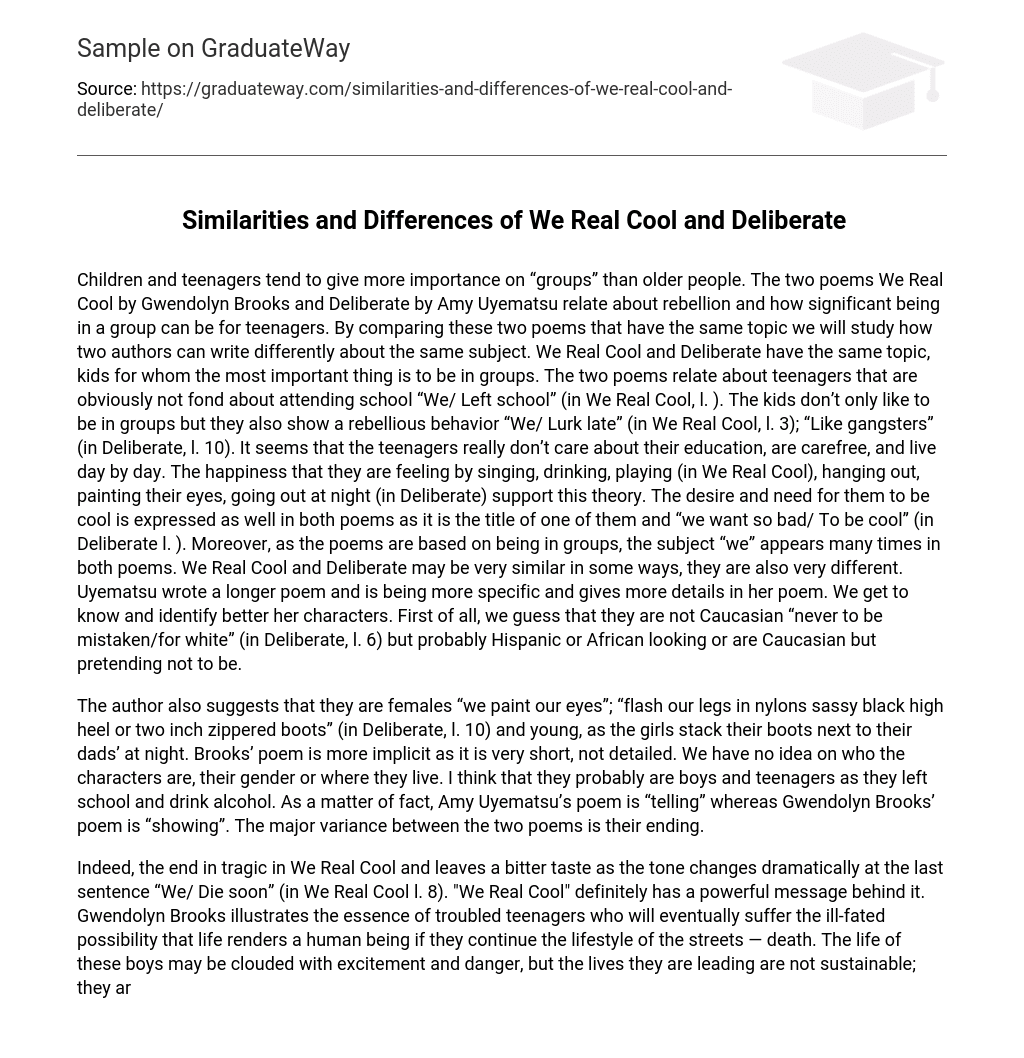Children and teenagers place a greater emphasis on belonging to “groups” compared to older individuals. Gwendolyn Brooks’ poem “We Real Cool” and Amy Uyematsu’s poem “Deliberate” both explore the themes of rebellion and the significance of group affiliation for teenagers. By examining these two poems which share a common subject, we can observe how two authors can approach the same topic with different styles. Both “We Real Cool” and “Deliberate” center around youths for whom group membership is of utmost importance. The two poems depict teenagers who clearly have little interest in attending school, as evidenced by phrases such as “We/ Left school” in “We Real Cool” (l. ). These young individuals not only enjoy being part of a group, but also exhibit rebellious behaviors, like lurking late (in “We Real Cool,” l.3) and behaving like gangsters (in “Deliberate,” l.10). It seems that these teenagers prioritize immediate gratification and do not concern themselves with their education, living carefree lives day by day. The feeling of happiness that they experience through activities such as singing, drinking, and playing in “We Real Cool,” as well as hanging out, painting their eyes, and going out at night in “Deliberate,” reinforces this notion. The desire and desperation to be seen as cool is also expressed in both poems; it serves as the title of one of them, and is further explained in lines such as “we want so bad/ To be cool” in “Deliberate” (l.). Additionally, since the poems revolve around group dynamics, the pronoun “we” appears frequently in both. While “We Real Cool” and “Deliberate” may share similarities in certain aspects, they also exhibit notable differences. Uyematsu’s poem is longer and provides more specific details compared to Brooks’.In order to gain a deeper understanding and recognition of her characters, we initially infer that they differ from Caucasian individuals, as indicated by the statement “never to be mistaken/for white” in Deliberate (line 6). They likely possess a Hispanic or African appearance, or alternatively, could be Caucasian individuals pretending to be otherwise.
The author also suggests that they are females, as indicated by phrases such as “we paint our eyes” and “flash our legs in nylons sassy black high heel or two inch zippered boots” (in Deliberate, l. 10). Additionally, the girls mentioned in the poem are young, as they stack their boots next to their dads’ at night. In contrast, Brooks’ poem is more implicit, lacking detailed information about the characters’ identities, gender, or location. It is possible that the characters in Brooks’ poem are boys and teenagers, considering that they leave school and consume alcohol. Strikingly, Uyematsu’s poem explicitly conveys information, while Brooks’ poem relies more on visual depiction. The main difference between the two poems lies in their respective endings.
Indeed, the ending is tragic in “We Real Cool” and leaves a bitter taste as the tone undergoes a dramatic change in the last sentence, “We/ Die soon” (in “We Real Cool” l. 8). Gwendolyn Brooks effectively communicates a powerful message through this poem. She portrays the essence of troubled teenagers who will ultimately experience the unfortunate consequences that life brings upon individuals if they continue living a street-oriented lifestyle – death. Although the lives of these boys may be filled with excitement and danger, the paths they have chosen are unsustainable, making it highly likely that they will meet their demise.





